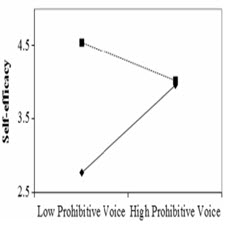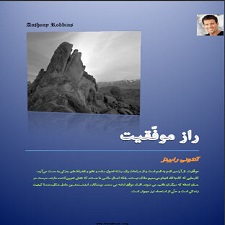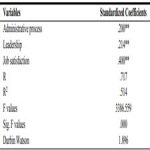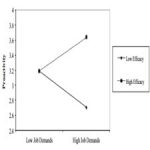توضیحات
ABSTRACT
Little is known about the consequences of promotive and prohibitive voice. Addressing this issue, this study empirically examined the relationship between promotive and prohibitive voice and job satisfaction, as well as the mediating role of selfefficacy and the moderating role of transformational leadership. Results from 88 employee–supervisor dyads indicated that promotive and prohibitive voice were positively related to job satisfaction. Moreover, the relationship between promotive voice and job satisfaction was fully mediated by self-efficacy, whereas the relationship between prohibitive voice and job satisfaction was partially mediated by self-efficacy. Transformational leadership moderated the effect of prohibitive voice on self-efficacy. Findings enrich the voice literature and provide practical implications. Organizations should encourage employees to engage in voice behavior and strengthen their self-efficacy. Team leaders should be trained and guided to keep suitable leadership style.
INTRODUCTION
Voice behavior, or Bconstructive change-oriented communication intended to improve the situation^ (LePine and Van Dyne 2001, p. 326), contributes to organizational effectiveness (Hsiung and Tsai 2017). It is believed to be a multifaceted construct (Maynes and Podsakoff 2014). According to Liang et al. (2012), voice can be divided into two types: promotive and prohibitive. Specifically, promotive voice aims to improve organizational functioning by putting forward innovative ideas and suggestions, while prohibitive voice attempts to prevent organizational failures by expressing concerns and worries. Both promotive and prohibitive voice are important for organizations (Lin and Johnson 2015), and how to stimulate promotive or prohibitive voice has drawn much attention from prior studies (e.g., Kakkar et al. 2016; Qin et al. 2014; Wei et al. 2015). However, little is known about the unique consequences of these behaviors, especially on the actors who engage in either promotive or prohibitive voice (Lin and Johnson 2015).
چکیده
درباره عواقب صدای تبلیغی و غیرواقعی کم است. با توجه به این موضوع، این مطالعه تجربی رابطه میان صدای تبلیغی و غلط و رضایت شغلی، و همچنین نقش میانجی از خودکارآمدی و نقش مدون کننده رهبری تحول آمیز را مورد بررسی قرار داد. يافته ها از 88 مدير اجرايي، نشان داد که صداي ارتقا يا غيرمستقيم با رضايت شغلي رابطه مثبت دارد. علاوه بر این، رابطه میان صدای تبلیغی و رضایت شغلی به طور کامل توسط خود کارآیی متاثر شد، در حالیکه رابطه میان صدای غلط و رضایت شغلی به طور جزئی از طریق خودکارآمدی متاثر شد. رهبری تحول گرایی، تأثیر صدای ممنوع بر خودآمدی را تعدیل کرد. یافته ها ادبیات صوتی را غنی می کنند و مفاهیم عملی را ارائه می دهند. سازمانها باید کارکنان را تشویق به شرکت در رفتار صوتی و تقویت خودکارآمدی خود کنند. رهبران تیم باید برای حفظ سبک رهبری مناسب آموزش ببینند و هدایت شوند.
مقدمه
رفتار صوتی یا ارتباطات متمرکز سازنده برای بهبود وضعیت ^ (LePine و Van Dyne 2001، ص 326)، به اثرگذاری سازمانی کمک می کند (Hsiung and Tsai 2017). اعتقاد بر این است که ساختار چندمنظوره (Maynes and Podsakoff 2014) است. به گفته لیانگ و همکاران (2012)، صدای را می توان به دو نوع تقسیم کرد: تبلیغی و غیر قابل پیش بینی. به طور خاص، هدف تبلیغاتی هدف بهبود عملکرد سازمانی است با ارائه ایده ها و پیشنهادات نوآورانه، در حالی که صدای ممنوعه تلاش برای جلوگیری از شکست های سازمانی با بیان نگرانی ها و نگرانی ها. هر دو صدای تبلیغی و غیرواقعی برای سازمان ها اهمیت دارند (لین و جانسون 2015) و نحوه تحریک صدای تبلیغی یا غیرواقعی از مطالعات قبلی توجه زیادی را به خود جلب کرده است (به عنوان مثال Kakkar et al 2016؛ Qin et al. 2014؛ Wei et al. 2015) با این حال، کمی درباره عواقب منحصر به فرد این رفتارها، به ویژه در مورد بازیگران که در صدای تبلیغاتی یا غیرواقعی شرکت می کنند، شناخته شده است (لین و جانسون 2015).
Year: 2018
Publisher : SPRINGER
By : Jun Song & Changqing He & Wei Wu & Xuesong Zhai
File Information: English Language/ 12 Page / size: 350 KB
سال : 1397
ناشر : SPRINGER
کاری از : Jun Song و Changqing He و Wei Wu و Xuesong Zhai
اطلاعات فایل : زبان انگلیسی / 12 صفحه / حجم : KB 350



![Lying and team incentives[taliem.ir]](https://taliem.ir/wp-content/uploads/Lying-and-team-incentivestaliem.ir_.jpg)

![Parenting interventions[taliem.ir]](https://taliem.ir/wp-content/uploads/Parenting-interventionstaliem.ir_.jpg)
![Abzare-Movafaghiat.[taliem.ir]](https://taliem.ir/wp-content/uploads/Abzare-Movafaghiat.taliem.ir_-1.jpg)


نقد و بررسیها
هنوز بررسیای ثبت نشده است.